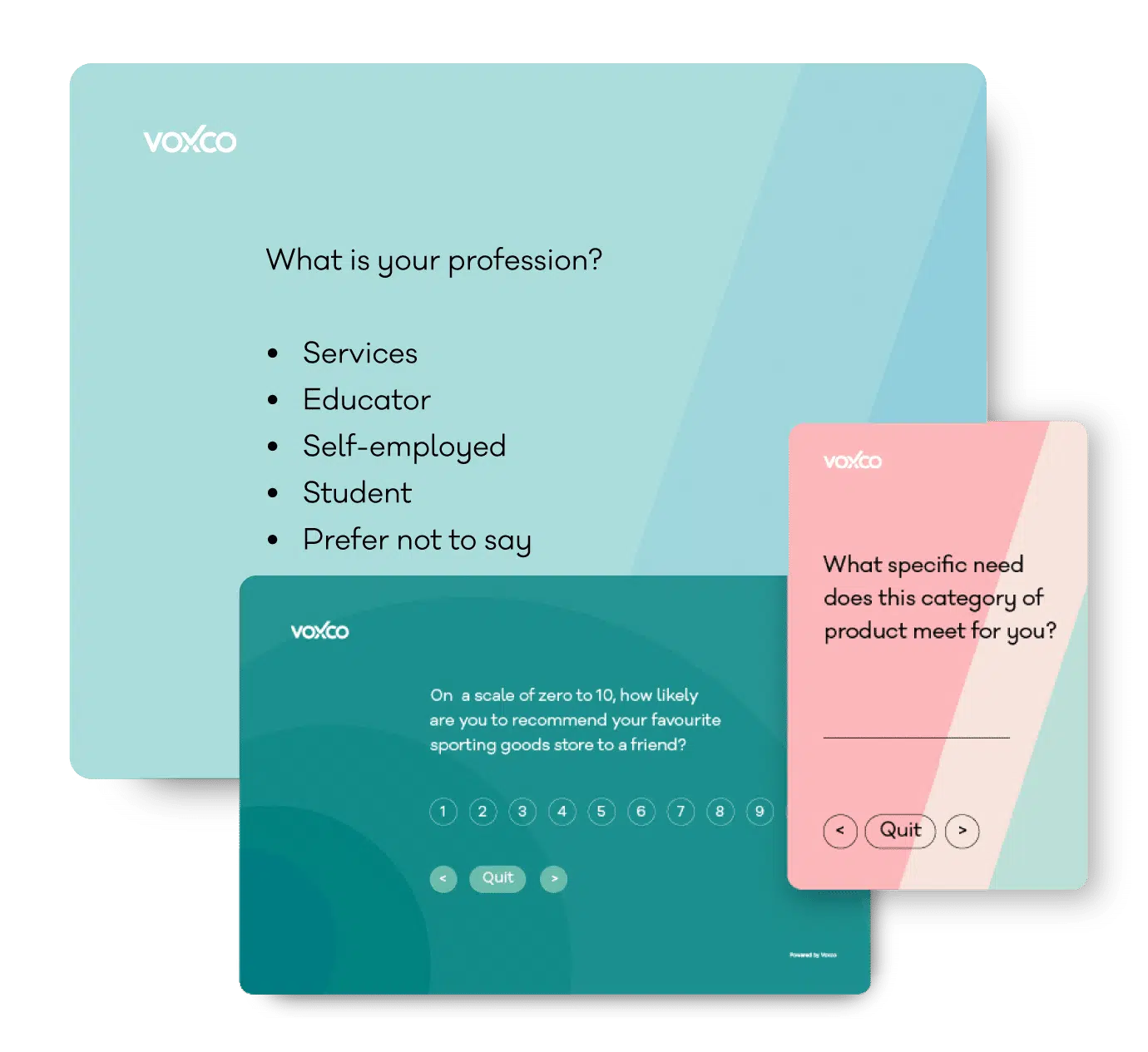Data Cleansing – Eliminate Data Errors to Grow the Business
Data Cleansing – Eliminate Data Errors To Drive Business Growth SHARE THE ARTICLE ON Table of Contents Data cleansing sounds like a funny term, but

Find the best survey software for you!
(Along with a checklist to compare platforms)
Take a peek at our powerful survey features to design surveys that scale discoveries.
Explore Voxco
Need to map Voxco’s features & offerings? We can help!
Find the best customer experience platform
Uncover customer pain points, analyze feedback and run successful CX programs with the best CX platform for your team.

We’ve been avid users of the Voxco platform now for over 20 years. It gives us the flexibility to routinely enhance our survey toolkit and provides our clients with a more robust dataset and story to tell their clients.
Steve Male
VP Innovation & Strategic Partnerships, The Logit Group
Explore Regional Offices

Find the best survey software for you!
(Along with a checklist to compare platforms)
Take a peek at our powerful survey features to design surveys that scale discoveries.
Explore Voxco
Need to map Voxco’s features & offerings? We can help!
Find the best customer experience platform
Uncover customer pain points, analyze feedback and run successful CX programs with the best CX platform for your team.

We’ve been avid users of the Voxco platform now for over 20 years. It gives us the flexibility to routinely enhance our survey toolkit and provides our clients with a more robust dataset and story to tell their clients.
Steve Male
VP Innovation & Strategic Partnerships, The Logit Group
Explore Regional Offices

Find the best survey software for you!
(Along with a checklist to compare platforms)
Take a peek at our powerful survey features to design surveys that scale discoveries.
Explore Voxco
Need to map Voxco’s features & offerings? We can help!
Find the best customer experience platform
Uncover customer pain points, analyze feedback and run successful CX programs with the best CX platform for your team.

We’ve been avid users of the Voxco platform now for over 20 years. It gives us the flexibility to routinely enhance our survey toolkit and provides our clients with a more robust dataset and story to tell their clients.
Steve Male
VP Innovation & Strategic Partnerships, The Logit Group
Explore Regional Offices
“If you want the right answers, you must ask the right questions.”
This famous saying stands true when it comes to surveys.
The success of a survey depends a great deal on its questions- the types of survey questions you choose, the way you ask questions and more. The more thoughtful you are when you create surveys and write survey questions, the closer you will be to obtaining accurate results.
But, framing good survey questions is a skill in itself. This is because poorly designed questions can lead to bad results, which will ultimately lead to bad insights.
If you put in the effort to write the best survey questions, you’ll be well on your way to obtaining the accurate responses you want to accomplish your aim.
This article will help you learn how to write the best survey questions and discover the best practices for writing good survey questions that offer relevant insights and data.
Let’s start by looking at different types of survey questions.
The first thing you need to know before you create surveys is the different types of questions you can use. Using a bunch of Yes/No questions will neither engage your respondents nor bring you any vital information.
Also, not everyone enjoys filling out surveys, so to ensure you get a high response rate, you must choose the right type of survey questions.
Here is a list of different types of survey questions:
Now, let us explore these types in greater detail.
Multiple-choice survey questions offer the respondents an array of 4-5 options to choose from. They have the option of selecting one or all the options that apply to them. Allowing the respondents to choose from a range of options makes it easier for them to complete the survey.
They are simple to use, offer data that is accessible to evaluate, and present mutually exclusive options.
Example of multiple choice survey question:
What types of credit cards do you have?
Likert scale questions are used to find out the extent to which a respondent agrees or disagrees with a particular question. The range of options includes extremes of opinions along with neutral opinions. These questions are often used to understand the respondents’ opinions on a given subject.
There are either odd or even Likert scales with options ranging from “highly satisfied” to “not at all satisfied” or “strongly agree” to “strongly disagree”. You can use either of these two Likert scale types to write survey questions based on the kind of data you want to collect.
Example:
How satisfied are you with our products?
Ranking survey questions give a list of options and ask the respondents to rank them in the order of priority. Such questions reveal how people feel about each option. The only drawback is that they do not explain why respondents make certain choices. But you can easily resolve this by following it with an open-ended question.
Example:
Rank the following food chains in the order of your preference. (1 = favorite & 5 = least favorite)
Dichotomous survey questions are short and basic survey questions that provide the respondents with two choices: Yes or No, True or False, Agree or Disagree, and so on.
This type of question is commonly used to categorize respondents. A dichotomous question can be used as a screening question – i.e., to filter out respondents who do not qualify for your survey purpose.
Avoid using a dichotomous question when asking about feelings and emotions because it is a neutral area where individuals would prefer to answer “maybe” or “sometimes.”
Example:
Do you have a driver’s license?
A matrix survey question is the type of survey question that is used to collect input from a target audience. The rows (see image below) reflect a set of questions about a topic, while the columns provide the response alternatives. When proportionally asking numerous questions regarding the same subject, it is ideal to utilize matrix questions.
Building surveys is easier with templates
Choose From 150+ FREE Survey Templates
Open-ended questions do not limit the respondents’ responses to a few options. Instead, they are asked alongside an empty text box to allow respondents to provide detailed responses.
They are usually paired with closed-ended questions and aid in understanding the respondents’ viewpoints in their own words.
When it comes to data analysis, open-ended questions aren’t the ideal choice. Since written responses are difficult to measure, text boxes are preferable for presenting qualitative data.
Example:
How did you feel about our customer service?
A closed-ended question is one from which respondents are given multiple choices to pick an answer from. Closed-ended questions allow for a restricted amount of responses and are good for surveys since consumers respond more quickly when they don’t have to write much.
Closed questions gather the information that may be utilized to establish broad generalizations based on statistical analysis. This type elicits a single straightforward response from the respondent.
A rating scale is a prominent closed-ended question form in which different weights can be assigned to each answer choice. Respondents are often asked to select from a range of alternatives from Unsatisfied to Satisfied.
The rating scale can assist you in quantifying subjective emotions such as fulfillment, experience, perception, fidelity, and so on. These scales are utilized because the questions are simple to grasp, offer insights across language hurdles, and may provide approximate responses without delving into further depth.
A dropdown question allows responders to select one of several alternatives from a list shown in the dropdown menu. When the responder clicks on the down arrow, the dropdown menu appears. Dropdown questions are simple to understand, given that they only allow one
response.
Demographic questions in a survey help researchers learn more about their survey participants. These questions give context to the survey data obtained, helping researchers to define their participants and evaluate their data more effectively.
Generally, putting the demographic section last leads to higher engagement with the questions, and better engagement leads to more comprehensive data and happier respondents.

Related: Check out survey question types offered by Voxco
Now that we have learned about the different types of survey questions you can use let’s check some of the best survey practices you must follow to create surveys that engage respondents.
One of the pitfalls of creating a survey is not asking the right questions correctly, resulting in exploited data leading to inaccurate results. This is why we’ve compiled some of the best practices for writing good survey questions.
|
Now, let’s deep-dive into these practices:
Open-ended questions will undoubtedly give you a clearer picture of the customer’s perspective.
However, if you ask a bunch of open-ended questions in the survey, the respondents may eventually drop out. Because such questions are time-consuming.
Furthermore, since the respondents are free to express themselves, irrelevant data may be collected. An ideal survey has a combination of both open-ended and closed-ended questions.
The respondents should not feel forced to give their answers. Sometimes, they may not know the answer to a question or may prefer to skip a particular question. The answer choices should reflect users’ emotions. They should include both extreme and neutral options. For example, consider the following options for a question about a customer’s experience at a hotel –
Imagine if a customer was not dissatisfied with their stay. The choices given above will not be enough. Instead, go for a diverse range of options as given below –
Each question in the survey should focus on a single subject at a time. Avoid merging multiple questions into a single one, as they will only confuse the respondents. Keep an eye out for questions with “and” or “or.”
For example, “Do you use both a mobile phone and a desktop?” What if the respondent uses only one of them? They will be unable to answer this question correctly. It is best to split such questions into two questions.
The way questions are phrased has a big impact on the survey’s performance. Questions based on assumptions have the potential to lead respondents to a specific response. The use of subjective terms like “great” and “amazing” can skew the results.
For example, “How satisfied are you with our amazing customer service?” – The question seems to express a point of view that you want people to agree with.
“How satisfied are you with our customer service?” – is a more subtle way to pose the question.
Phrases and slang are not understood by all. For example, if a survey is being conducted for school children, asking a lot of technical questions would simply confuse them. Therefore, it is best to stick to simple and clear language. A survey should be easy to understand and should not take more than a couple of minutes to complete.
Sometimes, some questions may provoke the respondents to agree with your opinion. This might give unfair results as they might not be able to express their true feelings.
Rather, you may ask, “How satisfied are you with our product quality?”
The most prevalent fallacy in surveys is double-barreled questions. However, they are reasonably simple to eliminate. It is a form of inquiry that combines more than one topic and asks about two separate concerns while only allowing one answer. They are problematic because the responses can be readily misconstrued, and there is no method for the respondent to specify which aspect of the question they have responded to.
Instead, you may ask separate questions such as “Do you like the taste of the food?” and “Do you like the plating of the food?”
Attention check questions, which ask participants to recall particular information from earlier in the survey, are sometimes used by researchers. These tests aim to distinguish between respondents who supply high-quality replies and those who provide low-quality or untrustworthy data.
If the respondent passes the attention check question, they will be directed to the next portion of the survey. Otherwise, they will be disqualified.
Some questions may lead to confusion and misinterpretation if not defined properly. Avoid ambiguous language to ensure that each respondent gives the same type of answer. Ask direct questions, and do mention the aim of asking a specific question.
Another important consideration is to always test your surveys before releasing them. With online survey tools, a pre-final version of the survey can be shared with friends, coworkers, etc. This way, you can test how participants respond to the questions. Gather a group of people and observe how they react to your survey.
This will allow you to find out if the questions are easy to understand for everyone or if the answer options are enough to express everyone’s opinion and more. If they appear to be struggling, you can bet that a few questions were incorrectly phrased.
These survey practices will always help you create surveys quickly. You can also use pre-made survey templates to learn how to create surveys before you become confident to write survey questions yourself.
To get better results, choose the correct type of survey questions that suit your survey’s objective. With the best survey questions, you will get high response rates which will aid in better insights into the results.
Also, try using online survey software that offers multiple questions and extends support in creating engaging surveys anytime you need. For example, Voxco offers 100+ survey question types that you can include in your surveys.
If you are not so sure about writing survey questions, you can also download pre-made survey templates from any robust online survey software. A survey template is designed by professional researchers on various research topics.
Create your surveys with Voxco
Named a leader in the survey software category by G2
See how it works-
Join the network of 500+ happy survey creators.
Explore all the survey question types
possible on Voxco
Read more
Data Cleansing – Eliminate Data Errors To Drive Business Growth SHARE THE ARTICLE ON Table of Contents Data cleansing sounds like a funny term, but

Unaided Brand Awareness SHARE THE ARTICLE ON Share on facebook Share on twitter Share on linkedin Table of Contents What is Unaided Brand Awareness? Brand
Business Research: Definition, Types, and Methods SHARE THE ARTICLE ON Table of Contents What is Business Research? Business research refers to the process of gathering

How To Become a Customer-Centric Organ SHARE THE ARTICLE ON Table of Contents Customer centricity means putting “people who add value to your business,” i.e.,
Predictive Analysis SHARE THE ARTICLE ON Table of Contents Predictive analytics forecasts future occurrences based on previous data. Typically, historical data is utilized to construct

Mobile Surveys Best Practice SHARE THE ARTICLE ON Table of Contents What is a Mobile Survey? A mobile survey is one that is completed by
We use cookies in our website to give you the best browsing experience and to tailor advertising. By continuing to use our website, you give us consent to the use of cookies. Read More
| Name | Domain | Purpose | Expiry | Type |
|---|---|---|---|---|
| hubspotutk | www.voxco.com | HubSpot functional cookie. | 1 year | HTTP |
| lhc_dir_locale | amplifyreach.com | --- | 52 years | --- |
| lhc_dirclass | amplifyreach.com | --- | 52 years | --- |
| Name | Domain | Purpose | Expiry | Type |
|---|---|---|---|---|
| _fbp | www.voxco.com | Facebook Pixel advertising first-party cookie | 3 months | HTTP |
| __hstc | www.voxco.com | Hubspot marketing platform cookie. | 1 year | HTTP |
| __hssrc | www.voxco.com | Hubspot marketing platform cookie. | 52 years | HTTP |
| __hssc | www.voxco.com | Hubspot marketing platform cookie. | Session | HTTP |
| Name | Domain | Purpose | Expiry | Type |
|---|---|---|---|---|
| _gid | www.voxco.com | Google Universal Analytics short-time unique user tracking identifier. | 1 days | HTTP |
| MUID | bing.com | Microsoft User Identifier tracking cookie used by Bing Ads. | 1 year | HTTP |
| MR | bat.bing.com | Microsoft User Identifier tracking cookie used by Bing Ads. | 7 days | HTTP |
| IDE | doubleclick.net | Google advertising cookie used for user tracking and ad targeting purposes. | 2 years | HTTP |
| _vwo_uuid_v2 | www.voxco.com | Generic Visual Website Optimizer (VWO) user tracking cookie. | 1 year | HTTP |
| _vis_opt_s | www.voxco.com | Generic Visual Website Optimizer (VWO) user tracking cookie that detects if the user is new or returning to a particular campaign. | 3 months | HTTP |
| _vis_opt_test_cookie | www.voxco.com | A session (temporary) cookie used by Generic Visual Website Optimizer (VWO) to detect if the cookies are enabled on the browser of the user or not. | 52 years | HTTP |
| _ga | www.voxco.com | Google Universal Analytics long-time unique user tracking identifier. | 2 years | HTTP |
| _uetsid | www.voxco.com | Microsoft Bing Ads Universal Event Tracking (UET) tracking cookie. | 1 days | HTTP |
| vuid | vimeo.com | Vimeo tracking cookie | 2 years | HTTP |
| Name | Domain | Purpose | Expiry | Type |
|---|---|---|---|---|
| __cf_bm | hubspot.com | Generic CloudFlare functional cookie. | Session | HTTP |
| Name | Domain | Purpose | Expiry | Type |
|---|---|---|---|---|
| _gcl_au | www.voxco.com | --- | 3 months | --- |
| _gat_gtag_UA_3262734_1 | www.voxco.com | --- | Session | --- |
| _clck | www.voxco.com | --- | 1 year | --- |
| _ga_HNFQQ528PZ | www.voxco.com | --- | 2 years | --- |
| _clsk | www.voxco.com | --- | 1 days | --- |
| visitor_id18452 | pardot.com | --- | 10 years | --- |
| visitor_id18452-hash | pardot.com | --- | 10 years | --- |
| lpv18452 | pi.pardot.com | --- | Session | --- |
| lhc_per | www.voxco.com | --- | 6 months | --- |
| _uetvid | www.voxco.com | --- | 1 year | --- |